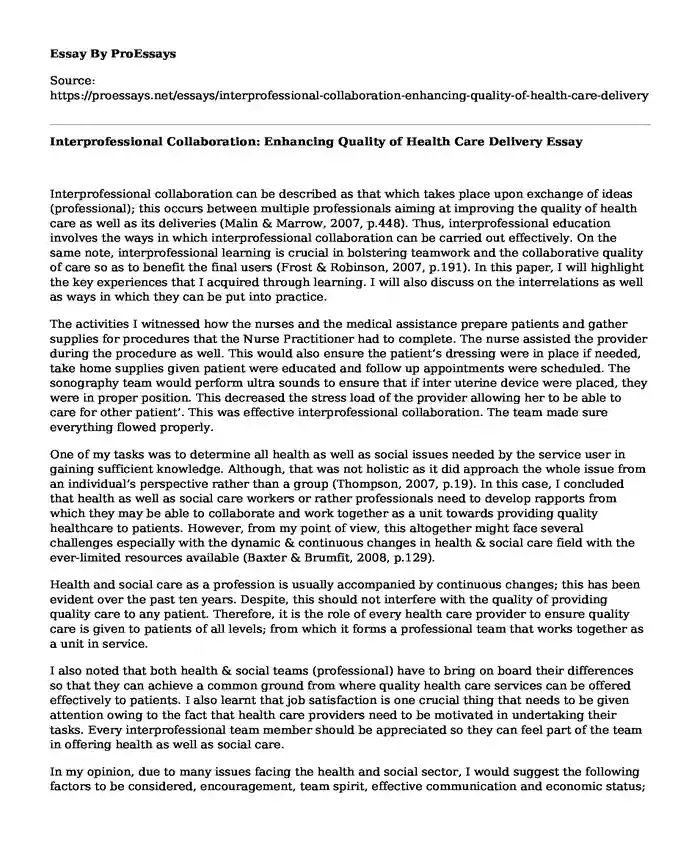Interprofessional collaboration can be described as that which takes place upon exchange of ideas (professional); this occurs between multiple professionals aiming at improving the quality of health care as well as its deliveries (Malin & Marrow, 2007, p.448). Thus, interprofessional education involves the ways in which interprofessional collaboration can be carried out effectively. On the same note, interprofessional learning is crucial in bolstering teamwork and the collaborative quality of care so as to benefit the final users (Frost & Robinson, 2007, p.191). In this paper, I will highlight the key experiences that I acquired through learning. I will also discuss on the interrelations as well as ways in which they can be put into practice.
The activities I witnessed how the nurses and the medical assistance prepare patients and gather supplies for procedures that the Nurse Practitioner had to complete. The nurse assisted the provider during the procedure as well. This would also ensure the patient's dressing were in place if needed, take home supplies given patient were educated and follow up appointments were scheduled. The sonography team would perform ultra sounds to ensure that if inter uterine device were placed, they were in proper position. This decreased the stress load of the provider allowing her to be able to care for other patient'. This was effective interprofessional collaboration. The team made sure everything flowed properly.
One of my tasks was to determine all health as well as social issues needed by the service user in gaining sufficient knowledge. Although, that was not holistic as it did approach the whole issue from an individual's perspective rather than a group (Thompson, 2007, p.19). In this case, I concluded that health as well as social care workers or rather professionals need to develop rapports from which they may be able to collaborate and work together as a unit towards providing quality healthcare to patients. However, from my point of view, this altogether might face several challenges especially with the dynamic & continuous changes in health & social care field with the ever-limited resources available (Baxter & Brumfit, 2008, p.129).
Health and social care as a profession is usually accompanied by continuous changes; this has been evident over the past ten years. Despite, this should not interfere with the quality of providing quality care to any patient. Therefore, it is the role of every health care provider to ensure quality care is given to patients of all levels; from which it forms a professional team that works together as a unit in service.
I also noted that both health & social teams (professional) have to bring on board their differences so that they can achieve a common ground from where quality health care services can be offered effectively to patients. I also learnt that job satisfaction is one crucial thing that needs to be given attention owing to the fact that health care providers need to be motivated in undertaking their tasks. Every interprofessional team member should be appreciated so they can feel part of the team in offering health as well as social care.
In my opinion, due to many issues facing the health and social sector, I would suggest the following factors to be considered, encouragement, team spirit, effective communication and economic status; these factors are responsible for the continuous changes that are experienced in health & social care and that they might be effective in fostering teamwork. Moreover, integration of a feasible working team can only be made possible through disposals of sufficient financial resources at the healthcare institutions. Through such a move, a stable workforce will be bolstered so it can work together in their teams effectively in ensuring promotion of the wellbeing of their organizations (Glasby & Dickinson, 2008).
Through my observations and experience that I gained, I am now able to visualize and relate the transition as well as facts that exist between theory & practice. Collaborative practice encompasses all the interprofessional requirements that nurses and doctors can exploit in dealing with complex situations.
References
Boling, A., & Schmer, C. (2020). Interprofessional Education: A Clinical Practicum withBaccalaureate Nursing and Respiratory Students. Biomedgrid. Retrieved 1 August 2020, from https://biomedgrid.com/fulltext/volume5/interprofessional-education-a-clinical-practicum-with-baccalaureate-nursing-and-respiratory-students.000955.php.
Glasby, J., & Dickinson, H. (2008). Greater than the sum of our parts? Emerging lessons for UK health and social care. International Journal Of Integrated Care, 8(3). https://doi.org/10.5334/ijic.246
Nursing students' reflections on an interprofessional placement in ambulatory care. Taylor & Francis. (2020). Retrieved 1 August 2020, from https://www.tandfonline.com/doi/abs/10.1080/14623943.2016.1164686?src=recsys&journalCode=crep20.
Wunderlich, R., Cavallo, C., Gettemeier, P., Eliot, K., & Ruebling, I. (2020). Nsuworks.nova.edu. Retrieved 1 August 2020, from https://nsuworks.nova.edu/cgi/viewcontent.cgi?article=1372&context=ijahsp.
Cite this page
Interprofessional Collaboration: Enhancing Quality of Health Care Delivery. (2023, Oct 29). Retrieved from https://proessays.net/essays/interprofessional-collaboration-enhancing-quality-of-health-care-delivery
If you are the original author of this essay and no longer wish to have it published on the ProEssays website, please click below to request its removal:
- Essay on Smartphone Encryption and Privacy
- The "Read to Succeed" Program Budget Paper Example
- Charles Darwin and His Theory Essay Example
- Essay Sample on How Data Clustering Affects Accounting
- Essay Example on Innovations in Nursing Curriculum for Enhanced Knowledge Acquisition
- Race, Prison Violence & Empirical Analysis: A Study
- Essay Example on Rising Cost of Healthcare: The Need for Innovative Solutions







